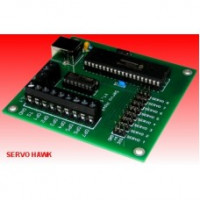Stepper Slave
The Stepper Slave provides full independant control of 2 stepper motors with limit switch inputs and some general purpose digital I/O. With a Master Controller already connected to the PC this slave module can be up to a massive 1Km away connected only by a single pair of low cost wires.

General: Stepper motors are one of the most useful devices in the world of control, automation and robotics. They form the most convenient and versatile bridge between a set of motion rules in a controller (computer) and the motion itself. They can be made to move slowly, quickly, in reverse, pause, complete revolutions, partial revolutions and even individual steps of less than a degree of rotation. With this flexibility of movement coupled with an abundance of torque for relatively little power applied, the stepper motor finds many suitable applications.
The downside to stepper motors is that they are not as simple to “drive” (electrically speaking) as ordinary DC motors, which just need the required volts and amps to do their bit. Stepper motors need a precise sequence of pulses delivered to the correct winding at the correct time in order to perform their required task. It would be nice if all you had to do was specify the number of steps to take , in what direction and at what speed and the stepper motor obliged. This is the function of the Stepper Slave board.
From the PC these requirements can be specified and “sent” to the Stepper Slave via the control master link. The stepper slave then generates the precise sequence of pulses on the appropriate winding to move the stepper motor accordingly. The Stepper Slave can accommodate two stepper motors operating completely independently using this technique. For example one stepper motor may be sent off to do 1000 steps clockwise at a rate of 1 step every 100ms followed by 100 steps anti-clockwise at 1 step per minute, whilst at the same time motor 2 can be executing it’s own task which might be to do 100 steps clockwise then anticlockwise in a continuous repeating way at a rate of 1 step/sec. The Stepper Slave sorts out the two motors pulse requirements and makes sure both motors are supplied with the correct “drive” to perform the specified tasks.
The ability to control two motors with independent tasks in this way opens up many possible application areas for the Stepper Slave which are not easily available with other stepper motor drives. Popular applications that take advantage of this are with x-y co-ordinate drive systems where one motor controls the X-position and one controls the Y. Specifying the appropriate sequence of tasks can produce some very elaborate positional oriented control systems.

Since the Stepper Slave also has two digital outputs available for the users program to make use of, it is then possible for these to be used to control a third or 4th axis (albeit in a more simple way) for applications that could, for example, operate a solenoid on the X-Y positioned device. In this way “pick and place” type applications spring to mind. Similarly the Stepper Slave has two digital inputs which are typically used to provide some form of feedback from the controlled device. For example a datum position could be established somewhere in the range of motion detectable and recognized by a sensor connected to one of these inputs.

It is very common for motion control systems to have limits on their range of motion. i.e. it may be that the moving object will reach an end-stop if left to continue or perhaps cause damage by making contact with other objects in the line of travel. For this reason it is often required to have “limit switches” fitted. These are placed to operate when the moving apparatus reaches them. Typically they are simple micro-switches or light-interruption devices. In any case they produce a signal indicating the moving object has reached its desired limit of travel. The stepper slave provides inputs specifically for these devices. For each motor there are two inputs. One for inhibiting forward motion and the other for inhibiting reverse. They are simple digital inputs “pulled up” to the on-board +5v via suitable resistors. This means that all the limit switch device has to do to is connect the input to 0v (GND) to activate this signal to the Stepper Slave. Once activated, the stepper slave will automatically stop the motion in that direction. For example: if motor 1 is currently moving forward, it can be stopped by simply connecting input “1F” to 0v (GND). It should be noted that while the motor is moving forward the action of connecting the reverse limit input to GND (i.e “1R” in this case) will have no effect. Activating a limit switch input takes effect very quickly since it does not rely on any PC communications taking place, i.e. it is handled entirely within the on board microcontroller.

Stepper Motor Controller for 2 Stepper Motors, BRD023, PC Control England
Product Code: In Stock
In Stock, Next Day Free Delivery
-
PKR 9,800
Related Products
Servo Motor Controller for 8 Servo Motors, Servo Hawk, BRD022
Servo Hawk Control Board Directly and independently control up to 8 standard servos with the S..
PKR 8,900
USB Control for 30 Digital and Analogue Inputs / Outputs, DIY Hawk, BRD025
DIY Hawk When you need, or prefer, more control over the "add on" electronic..
PKR 8,500
PCI-6601, NI-DAQ, 4 Up/Down Counter/Timers, 8 Digital Inputs/Outputs, Condition New Original Box Pack
PCI-6601, NI-Data Acquisition Card, Condition New Original Box Pack5 V, 4-Channel Counter/Timer Devi..
PKR 49,000
Stepper Motor Hybrid RS PRO, Step Size 1.8°, Holding Torque 0.88Nm, Voltage Rating 5.4 V dc, Current 1.4 A, 8 Wires, RS England
Product Details Stepper Motors With/Without Rear Shaft ExtensionsRS Pro stepper motors wi..
PKR 9,700
Tags: Stepper Motor Controller for 2 Stepper Motors, BRD023 by PC Control in Pakistan





